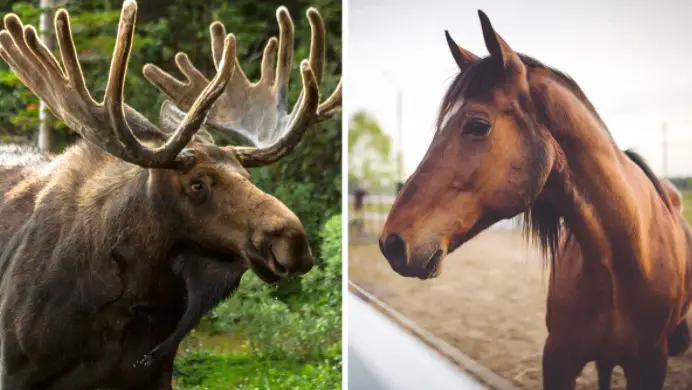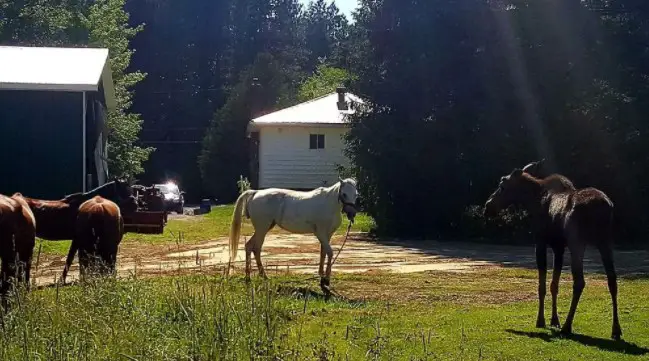In this article, we will compare these two unique animals. Our focus will be on their weight, height, speed, and much more.
You might know that horses and moose are not similar animals. However, sometimes people think moose and horses have the same size. This may be true, yet it depends on the horse breed used for the comparison. Hence, it is pretty fair to use a generalized approach to figure out which animal weighs more, stands taller, or runs faster.
Moose and horses can have similar height, weight, and strength in particular growth stages. Although, they become slightly distinctive when we talk about color, hooves, and coat type. The thin line that separates these two animals makes them worth comparing.
We have all seen a horse before. However, not everyone, even those who watch TV often may know what a moose looks like. One thing is sure, horses are more accessible than moose.
Therefore, we need to understand these two species deeply. After discussing their features, we will move ahead to discuss their differences and similarities.
Moose
Moose are considered the largest deer species and tallest mammals in North America. U.S, Canada, Europe, and Asia. These are also mapped geographic locations for moose. They are herbivores and primarily feed on grass. Adult moose measure up to 6 feet tall. They possess fur skin that hangs from their throats. Moose also have long faces and muzzles draping from their chins. Ears are small, and so are their tails.

Adult male moose develop massive antlers of about six feet wide. These antlers start to develop in late spring or early summer. On average, the antlers weigh up to 40 pounds. However, the antlers deteriorate in the winter season. The shoulders of these animals have tremendous muscles which appear as a hump. Speaking of their weight, males weigh about 700 kg, and females typically weigh 400 kg. Different breeds have coats with different brown shades. They can be reddish-brown, greyish brown, or dark brown.
Moose have typically long faces and legs. The front pair of legs is slightly longer than the back pair. This makes them look clumsy and gangly. While looking at their legs, it seems like they have worn white leggings. These are unique features that make it easy to identify moose.
They have also been around for a long time, just like horses. Some of the moose cave paintings are as old as 6,000 years. This indicates that man has lived close to moose for many years.
Moose prefer living in herds, especially during the breeding period. However, they seem to be distant from other herd fellows. Other than the breeding period, they are typically antisocial. Moose often have animal fights, especially between males. As soon as the mating season arrives, males begin to fight to secure a female moose for mating.
They are most active at dawn and dusk. While they are not quite good at sighting, moose have a great sense of smell and hearing. Also, this animal is an exceptional swimmer. They can swim 6 miles per hour. They can even stay underwater for 30 seconds at a stretch.
Although moose are very calm in their habitat, they might get aggressive once they feel threatened by other animals or humans around them. In fact, a moose will attack any animal or human when they feel intimidated in their space as they are pretty territorial.
Horse
Over 50 million years, horses have evolved from small and several-toed animals to single-toed sublime equines. Some horses are domesticated. These are the horse breeds people use for their daily chores. In comparison, some horses are wild. During ancient times, people used domestic horses for transportation and during wars.

The weight and size of horses can differ according to the breed. Although, they possess similar features. For example, all horses have long necks that hold their enormous heads. Furthermore, they can adjust to every environment because of their big eyes and ears.
Horses grow long hair starting from the back of their necks. Moreover, the hair on a horses’ short tail is coarse.
In addition, horses are majorly known as hoofed mammals. The hooves of these animals are made of horn material that can be of different colors. The color variation of their hooves is due to the continuous breeding over time.
These mammals have extraordinary auditory senses, such as 360-degree hearing. Moreover, they have a strong sense of smell compared to other animals. But, horses still depend on their sight rather than their sense of smell.
Horses can graze all day long. Besides, these animals are capable of differentiating poisonous and harmless plants. Yet, if they fail to find sufficient food, they will feed on toxic plants.
These creatures can readily survive in every type of climate. Domestic horses can survive in extreme environments as long as they have food and space to live and run. Also, horses are herbivores. Grass and hay are the most critical parts of their diet. These two feeds support their digestion. Apart from that, they love munching on fruits and vegetables.
Similarities in Moose vs. Horse

Diet
Horses are animals that graze naturally. Their diet is grass which has high roughage content. The unique digestive system of horses is pretty distinctive from others. They prefer to eat for a long time and take quick naps. Other than grasses, they are more likely to munch on hay, rich in vitamins and minerals.
On the other hand, moose, too, are herbivores. The word “moose” means “eater of twigs.” During the spring season, they feed on grass. Moose also eat leaves, twigs, and barks from trees. They also like to chew on some aquatic plants in ponds and streams.
Survival Strategy
When moose feel threatened by other animals or humans, they usually run away. But, under some conditions, they can become aggressive and charge at anyone. They are likely to kick, stomp, or even use their antlers to attack predators, such as wolves and bears. Moose will also act aggressively to protect their young ones.
Likewise, horses do the same. These animals are fight-or-flight creatures. They mostly prefer fleeing to escape the danger. But when running away is not an option, they choose to bite, strike, kick and stomp. A horse’s kick is considered deadly enough to eliminate all threats.
Physical Skills
Apart from attacking with antlers, moose can also bite with a tremendous force. Their bite is considered vicious, likely to kill any animal. Moose are pretty good swimmers as well. You can witness a moose enter the lake and swim six miles per hour. They are capable of kicking off their enemy with sharp hooves.
Regarding physical skills, horses are also exceptional kickers. A horse’s kick can kill a human or predator. Their kicking speed is estimated to be about 2,000 psi. Additionally, a horse’s jaws and teeth can cause harm with a biting force of 500 psi.
Differences in Moose vs. Horse

Habitat
Moose live in the northern regions of America, Alaska, Washington, and throughout Canada. They are bound to live in cold climatic areas because of their large size and insulating fur. Forests with ponds and streams around are ideal for moose.
In contrast, horses live in every region except northern arctic areas of North America, Europe, Asia, and Antarctica. Most of the horses are domesticated. Therefore, they live in ranches and farms managed by humans.
Physical Characteristics
Similar to cows, moose possess four-chambered stomachs. They bring up their digested food and chew on it. These creatures have solid and heavy antlers to protect themselves. Unlike moose, horses have only one stomach.
Social Behavior
Speaking of the social behavior of moose, they are highly antisocial and solitary animals. Moose are only found in herds during the breeding season because they need cows for mating. Apart from that, they mostly prefer living and traveling alone.
Comparing moose vs. horse, horses are majorly social animals. They like to stay with their herd. Horses are more expressive because they communicate through body language and vocalization.
Life Span
Moose can live up to 20 years. Their life span falls between 15 years and 20 years. This short life span of such an enormous wild animal is hugely related to the moose’s wildlife environment. Predators kill many moose, accounting for their short lifespan.
Compared to moose, domesticated horses live longer, and their life span ranges between 25 and 30 years. Generally, horses can survive well in their thirties on farms and ranches. Meanwhile, wild horses have a much shorter life span than moose due to predators like bears and wolves.
Final Thoughts
Finally, moose and horses are two distinctive creatures with some similarities and differences. Both of them are herbivores, yet they both have different eating habits. Horses and moose have similar physical skills and survival strategies, but their habitat preference differs. In conclusion, horses have more commercial value than moose. They are sold for high prices and used in prestigious equestrian sports.
